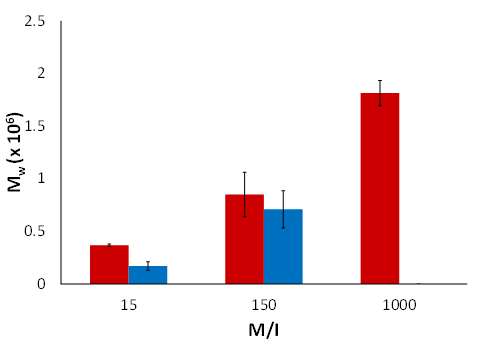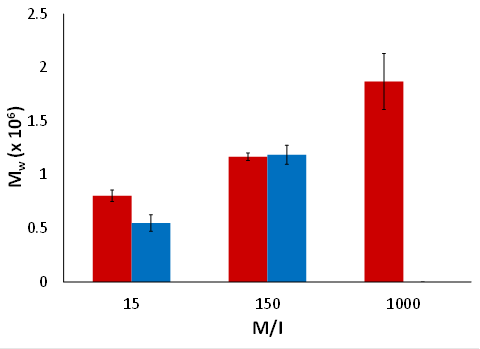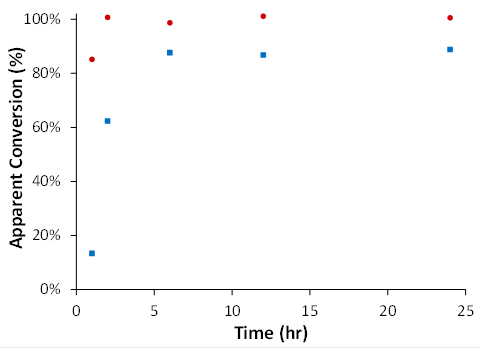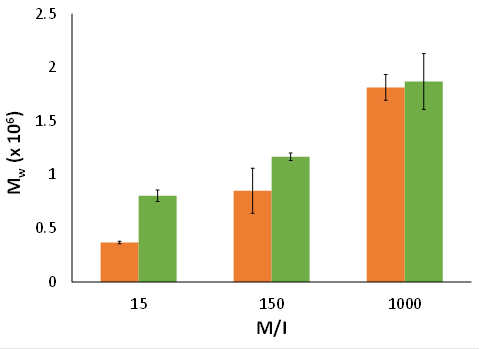Reports: DNI753294-DNI7: A Fresh Perspective on Admicellar Polymerization: Determining the Effects of Deoxygenation, Monomer Partitioning, and RAFT Polymerization on Thin Film Formation
Adam E. Smith, PhD, University of Mississippi
Effect of Oxygen on Admicellar Polymerization In previous investigations, admicellar polymerizations
utilized a low monomer-to-initiator ratio relative to emulsion polymerization. In
order to investigate the effect of deoxygenation on the polymer yield and
molecular weight, we examined M/I of 15, 150, and 1000 for six
hour polymerizations initiated by either AIBN or V-501 (Table 1). If all
of the added styrene polymerized, it would result in a 4.9% weight loss above
300 The polymer synthesized at an M/I of 15 showed a
significantly lower Mw when polymerized in the presence of oxygen.
Additionally, the mass of polymer formed under an inert environment was greater
than the comparable polymerization system containing oxygen. This effect can best be observed in the samples at an M/I of 1000. At
M/I of 1000, the AIBN deoxygenated admicellar polymerization system achieved an
apparent conversion of 84% while the control sample had an apparent conversion
of 11%. The presence of oxygen did not show a significant effect on the mass of
the polystyrene formed at an M/I of 15 (Table 1), likely due to excess
initiator available to compensate for the loss of active radicals to oxygen.
Kinetics of Admicellar Polymerization Another focus for the project has been to investigate the
kinetics of admicellar polymerization. The effect of varying the M/I on the
kinetics of admicellar polymerization was examined by
determining the apparent conversion at varying polymerization times (Figure 3).
Results show that increasing the M/I reduced the admicellar polymerization
rate, as expected. The polymerization at a M/I of 15
achieved Effect of Initiator Solubility We investigated the effect of using a water-soluble and a water-insoluble
initiator on the yield and molecular weight of polymer formed via admicellar
polymerization. The apparent conversion was similar for comparable M/I
regardless of the initiator used (Table 1). Higher Mw polymer,
however, was formed in admicellar polymerization with
the water-soluble initiator (V-501) especially at an M/I of 15 (Figure 4).
These results agree with emulsion polymerization systems in which high
molecular weight polymer can be achieved when using
water-soluble initiator. Water-soluble initiators partition into the admicelle
to a lower degree than the more insoluble initiators. Therefore, fewer
polymerization sites were available resulting in higher molecular weight
polymer using a water-soluble initiator.
Being the first research grant awarded to the PI, the ACS
PRF award enabled significant progress in understanding the fundamental
parameters controlling admicellar polymerization. This project has produced two
manuscripts currently under review and another in preparation. The support
received from this award was instrumental in providing the resources for two
graduate students and four undergraduates to have contributed to this work. The
students’ work has resulted in one graduate and one undergraduate student
presentations at national conferences.
















